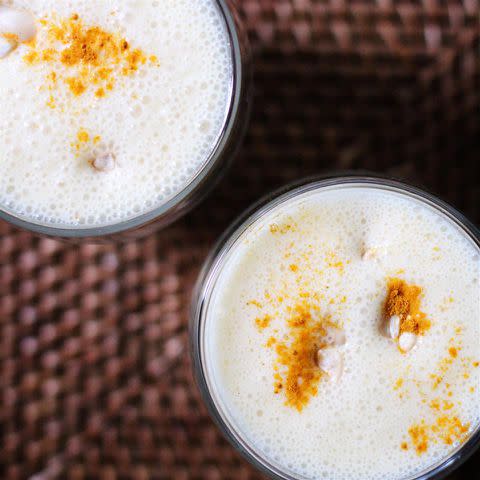What Is Turmeric? The Guide to Using This Ancient Spice in Your Kitchen
Discover how to use this vibrant spice in everyday cooking.

Looking to add a little twist to your scrambled eggs and roasted veggies? You may want to visit your local grocery and pick up a bottle of turmeric powder —you could be pleasantly surprised with how a little dash could make your dishes extra delish.
This yellow-orange spice has been a staple for culinary and medicinal uses in India and Southeast Asian countries for centuries. If you have never used turmeric root, discover how you can add it to everyday cooking, its potential health benefits, and how to prepare and store it.
Related: The Best Anti-Inflammatory Foods to Eat (Plus Eight to Avoid)
What Is Turmeric?
Turmeric (scientific name Curcumma longa) is a rhizome; a fleshy undergrown stem part of the ginger family. As a relative to ginger, turmeric looks similar to ginger root, except it has a deep orange-yellow flesh rather than a dull yellow one.
Turmeric originates and exports from India and Southeast Asia. As a mainstay spice in Indian cooking, this rhizome has been used for centuries as a dye, food coloring, flavor agent, and an ingredient for traditional medicine.
This root is sold whole in the produce section, as a powdered culinary spice, or as an ingredient part of a spice blend, such as Indian garam masala. Surprisingly, turmeric is also a key ingredient for Worcestershire sauce, curry powder, relish, and pickles, amplifying their bold flavors.

Get the recipe: Cindy's Yellow Rice
What Does Turmeric Taste Like?
Turmeric consists of a combination of flavors. Many would describe this rhizome’s taste as similar to ginger and mustard, offering bold, peppery, earthy, bitter, and musky flavors with a hint of citrus.
Fresh vs. Dried
While turmeric is commonly ground into a spice, fresh turmeric roots can be found in specialty food stores. The turmeric root looks very much like a ginger root—both have knobby skins, except the turmeric root has an orange fleshy interior.
You can peel the outer skin to use the fresh turmeric root and then grate or slice it to make your very own turmeric paste. You can also make the turmeric spice by drying the sliced or grated root before grinding it into a powder.
Fresh turmeric is less potent than the powdered form. This means you will need three times the amount of fresh turmeric to equal one serving of turmeric powder.

Get the recipe: Turmeric Mango Smoothie
Health Benefits of Turmeric
Turmeric has been an ingredient in traditional Chinese and Indian Ayurvedic medicines for centuries. In Western medicine and research, turmeric is lauded for the presence of an active compound, curcumin, which is believed to have anti-inflammatory and antioxidant properties.
Curcumin could potentially ward off free radicals from damaging body cells and reduce the likelihood of chronic inflammation in the body. While acute inflammation is normal, chronic inflammation could lead to the development of chronic conditions like cancer, heart disease, diabetes, and more.
Turmeric may also play a role in alleviating symptoms related to arthritis and depression, in addition to lowering the risk of Alzheimer’s disease.
Related: Easy Chicken Curry Dinners from Around the World
Because of its potential health benefits, you could find turmeric extracts as a dietary supplement on the market.
How to Cook with Turmeric
Turmeric has a bold and bitter taste, and it lends in well with ingredients like coconut milk and butter that balance the flavors and tame the spice’s bitterness. It can be used as an ingredient of a marinade, a dry rub, and a base for broths, like our Instant Pot Bone Broth with Turmeric and Ginger.
You can also add a spoonful to milk, make a soothing Ginger Turmeric Herbal Tea, or whip up delicious Citrus, Turmeric, and Ginger Juice.
Turmeric is a staple in a variety of Indian dishes, including chicken tikka masala, chickpea curry, and many more.
Because of its bold and deep natural color, turmeric can easily stain your hands, clothes, and kitchen countertops. Consider wearing gloves and an apron or covering your countertop while prepping your foods with turmeric.
Related: What Does It Mean to 'Bloom' Spices?
How to Store Turmeric
Like other ground spices, store ground turmeric in an airtight container in a cool, dark place for up to six months. After that, it starts to lose its potency.
Similar to raw ginger root, raw turmeric root can be stored in a brown paper bag or in a sealed container in the vegetable drawer of the refrigerator for up to two weeks.
You can also freeze the fresh roots in the freezer for up to six months. Simply use a brush to scrub off the dirt and place them in an airtight food-grade bag or a container.
Read the original article on All Recipes.

